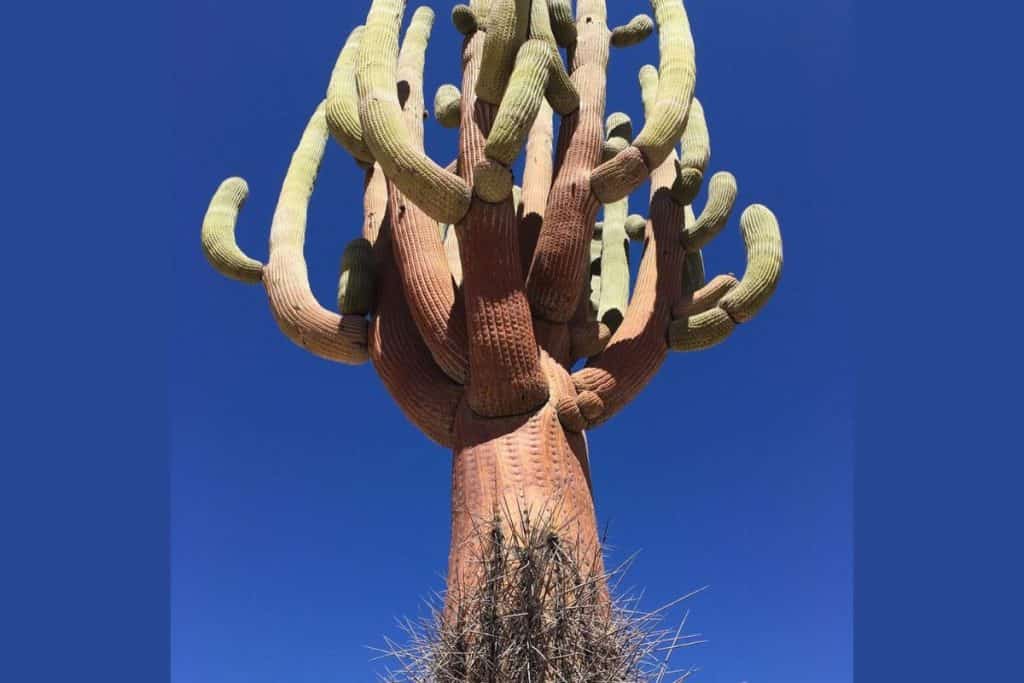Unraveling the Mysteries of Browningia Candelaris’ Bizarre Growth Habit
In the arid landscapes of northern Chile and southern Peru, a peculiar cactus species defies all conventions. Imagine a towering plant adorned with a thick, spiny trunk that soars up to 20 feet in height, crowned by a canopy of slender, almost spineless branches. This is the extraordinary Browningia candelaris, a botanical oddity that has captivated cactus enthusiasts worldwide with its bizarre growth habit.

Contents
About Browningia Candelaris
Native to the sun-baked regions of South America, Browningia candelaris, also known as the candleholder cactus, is a true marvel of nature. This remarkable species challenges traditional cactus growth patterns, sporting a distinct tree-like form that sets it apart from its prickly peers.
As it matures, Browningia candelaris develops an unbranched trunk up to 20 inches in diameter, densely cloaked in straight, formidable spines ranging from 2 to 10 inches long. Atop this spiny fortress sits a crown of thinner, branching stems, some of which are entirely spineless, while others bear a few harmless bristles. With approximately 50 ribs adorning each stem, this cactus is a true architectural wonder.
Related Post:
1,000 Types of Cactus [With Pictures]
How to Care for Browningia candelaris

Light Requirements
Browningia candelaris thrives in an environment drenched in sunlight. While it appreciates some respite from the scorching afternoon rays, this cactus revels in full sun exposure. If you’re cultivating it indoors, consider investing in a high-quality grow light to mimic its natural habitat.
Watering Needs
Like most cacti, Browningia candelaris is a water-wise plant, but it still requires proper hydration to maintain its unique structure. Follow the “soak and dry” method, watering the plant only when the top inch of soil is completely dry. Overwatering can lead to root rot, so exercise caution and let the soil dry out between waterings.
Soil Preferences
To ensure optimal growth, Browningia candelaris prefers a well-draining, coarse soil mix specifically formulated for cacti and succulents. Opt for a commercial cactus potting mix or create your own blend by combining equal parts of potting soil, perlite, and coarse sand.

Fertilizing Tips
While not strictly necessary, you can give your Browningia candelaris a gentle boost by applying a balanced cactus fertilizer during its growing season (summer months). Look for a fertilizer with a higher potassium content to encourage robust growth and flowering.
Temperature and Humidity
Hailing from the warm, arid regions of South America, Browningia candelaris thrives in temperatures ranging from 60°F to 90°F (15°C to 32°C). It prefers low humidity levels and cannot tolerate prolonged exposure to temperatures below 28°F (-2°C).
Pests and Problems
Browningia candelaris is generally resilient against pests and diseases, but it’s essential to watch out for common cactus pests like mealybugs, scale insects, and spider mites. Additionally, root rot can occur if the plant is overwatered, so ensure proper drainage and allow the soil to dry out between waterings.
Pruning and Grooming
Due to its unique growth habit, Browningia candelaris doesn’t require extensive pruning. However, you can remove any damaged or discolored stems to maintain its overall appearance and promote healthy growth.
Potting and Repotting
When it comes to potting, Browningia candelaris appreciates a well-draining container with ample room for its extensive root system. Repot your plant every two to three years in the spring, using a fresh cactus potting mix and a slightly larger container to accommodate its growth.
Browningia candelaris Propagation Methods

While propagation from seeds is possible, it’s a slow and challenging process due to the plant’s leisurely growth rate. A more practical approach is to propagate Browningia candelaris from stem cuttings:
- Using a clean, sharp knife, take a cutting from a healthy stem.
- Allow the cutting to callus over for a few days before planting.
- Plant the calloused cutting in a well-draining cactus potting mix.
- Water sparingly until roots have established, then follow the standard watering guidelines.
With its striking appearance and unique growth habits, Browningia candelaris is a true conversation piece in any cactus collection. By understanding its quirks and providing the proper care, you can unlock the secrets of this remarkable plant and watch it flourish into a living sculpture that will captivate everyone who lays eyes upon it.
